(2) Lambok Hermanto Sihombing
*corresponding author
AbstractCaci dance is one of the traditional fighting dances that is unique and contains an intense value. Caci is often displayed during traditional events of the Manggarai tribe. This shows that Caci is an essential part of the journey of the Manggarai community. Caci dance is now widely known because of its uniqueness and because the dance moves are hazardous because they contain physical violence; this is undoubtedly very interesting to study more deeply. The main problem is How the value of Caci reduces the perspective of Violence in Caci perceived by the audience. This study aims to determine the values that exist in the Caci dance and how the true meaning of Caci is so that it can change the perspective of the broader community that Caci is not only a dance that teaches physical violence. This descriptive qualitative research is located in Lentang Village, Lelak District, Manggarai Regency. Data was collected directly from local sources through interviews with traditional leaders and conducting a content analysis on YouTube channels categorised as having many viewers, national television channels, and Caci performances. This study shows that the art of Caci dance does not teach physical violence. Still, Caci has strong historical values and influences the social life of the Manggarai community. Caci has a definite philosophical meaning, showing the character of the Caci players. In conclusion, the values contained in Caci can strengthen socio-cultural values in the Manggarai community, in this case, significantly able to maintain the existence of Caci dance as a cultural identity with the values of life contained in it
KeywordsCaci Dance; Culture Values; Violence; Manggarai Tribe; Fighting Dance
|
DOIhttps://doi.org/10.31763/viperarts.v4i1.595 |
Article metrics10.31763/viperarts.v4i1.595 Abstract views : 2242 | PDF views : 851 |
Cite |
Full Text Download Download
|
References
[1] A. Abas, A. Aziz, and A. Awang, “A Systematic Review on the Local Wisdom of Indigenous People in Nature Conservation,†Sustainability, vol. 14, no. 6, pp. 1–16, Mar. 2022, doi: 10.3390/su14063415.
[2] A. Permatasari, W. Dhewanto, and D. Dellyana, “The role of traditional knowledge-based dynamic capabilities to improve the sustainable performance of weaving craft in Indonesia,†J. Enterprising Communities People Places Glob. Econ., vol. 16, no. 1, Feb. 2022, doi: 10.1108/JEC-11-2021-0156.
[3] M. Erb, “Adat revivalism in western Flores: Culture, religion, and land,†in The revival of tradition in Indonesian politics, New York: Routledge, 2007, pp. 267–294. Available at: Google Scholar.
[4] D. M. Tualaka and K. B. Jama, “Local wisdoms in Caci, a traditional art performance by Manggaraians in East Nusa Tenggara,†in International Seminar on Nusantara Heritage, 2017, pp. 136–142. Available at: Google Scholar.
[5] J. M. Immanuel, “Peace Building by Cultural Communities: Learning from Indonesian Cultures and Several Considerations,†Kontekst. J. Penelit. Sos. Keagamaan, vol. 25, no. 1, pp. 1–16, 2010. Available at: Google Scholar.
[6] A. Skukauskaite, I. Yilmazli Trout, and K. A. Robinson, “Deepening reflexivity through art in learning qualitative research,†Qual. Res., vol. 22, no. 3, pp. 403–420, Jun. 2022, doi: 10.1177/1468794120985676.
[7] V. Braun and V. Clarke, “Conceptual and design thinking for thematic analysis.,†Qual. Psychol., vol. 9, no. 1, pp. 3–26, Feb. 2022, doi: 10.1037/qup0000196.
[8] S. Farrall, “Where Have All the People Gone? Theories of Structuration, Practice and Agency,†in Building Complex Temporal Explanations of Crime, Springer, 2021, pp. 89–109. doi: 10.1007/978-3-030-74830-2_6
[9] T. Legrand, “The Third Way and the Landscape of Welfare Reform: Australia, UK and USA,†in The Architecture of Policy Transfer, Springer, 2021, pp. 129–159. doi: 10.1007/978-3-030-55821-5_5
[10] N. Heidenstrøm, “The utility of social practice theory in risk research,†J. Risk Res., vol. 25, no. 2, pp. 236–251, 2022, doi: 10.1080/13669877.2021.1936608.
[11] C. Wiencierz and U. Röttger, “The change process to agile public relations,†Public Relat. Rev., vol. 47, no. 5, p. 102108, 2021. doi: 10.1016/j.pubrev.2021.102108
[12] K. S. Jerath, “Introduction to Cross Cultural Communication,†in Science, Technology and Modernity, Cham: Springer International Publishing, 2021, pp. 147–159. doi: 10.1007/978-3-030-80465-7_9
[13] R. Tian, “The Study of the Cross-Cultural Communication of Mulan based on 5W Communication Model,†in 2021 3rd International Conference on Literature, Art and Human Development (ICLAHD 2021), 2021, pp. 256–260, doi: 10.2991/assehr.k.211120.047.
[14] C. H. Karjo, “Phonetic and Phonotactic Analysis of Manggarai Language,†in International Congress of Indonesian Linguistics Society (KIMLI 2021), 2021, pp. 79–83. doi: 10.2991/assehr.k.211226.018
[15] A. J. Ashley, C. G. Loh, K. Bubb, and L. Durham, “Diversity, equity, and inclusion practices in arts and cultural planning,†J. Urban Aff., vol. 44, no. 4–5, pp. 727–747, 2022. doi: 10.1080/07352166.2020.1834405
[16] K. Kuwat, “Tracing the bongkel: bamboo music of rural farmers in Banyumas, Central Java, Indonesia,†Int. J. Vis. Perform. Arts, vol. 3, no. 2, pp. 85–97, Dec. 2021, doi: 10.31763/viperarts.v3i2.545.
[17] T. B. K. Ofosu, “Youthful Bodies as Mnemonic Artifacts: Traversing the Cultural Terrain from Traditional to Popular Dances in Post-independent Ghana,†in Cultural Memory and Popular Dance, Springer, 2021, pp. 137–153. doi: 10.1007/978-3-030-71083-5_8
[18] K. Schupp, “Rethinking the pedagogy of dance pedagogy,†Res. Danc. Educ., vol. 23, no. 2, pp. 1–14, Jun. 2022, doi: 10.1080/14647893.2022.2083596.
[19] M. Fitzgerald and E. Standley, “Conversations on Change: A Project About Women, Dance, and Aging,†in Dancing Across the Lifespan, Cham: Springer International Publishing, 2022, pp. 225–242. doi: 10.1007/978-3-030-82866-0_14
[20] X. Dou, H. Li, and L. Jia, “The linkage cultivation of creative thinking and innovative thinking in dance choreography,†Think. Ski. Creat., vol. 41, p. 100896, Sep. 2021, doi: 10.1016/j.tsc.2021.100896.
Refbacks
- There are currently no refbacks.
Copyright (c) 2022 Maria Paskalia Aninda, Lambok Hermanto Sihombing

This work is licensed under a Creative Commons Attribution-ShareAlike 4.0 International License.
___________________________________________________________
International Journal of Visual and Performing Arts
ISSN 2684-9259
Published by Association for Scientific Computing Electronics and Engineering (ASCEE)
W: http://pubs2.ascee.org/index.php/viperarts
E: sularso@ascee.org
Organized by:
 This work is licensed under a Creative Commons Attribution-ShareAlike 4.0
This work is licensed under a Creative Commons Attribution-ShareAlike 4.0
























